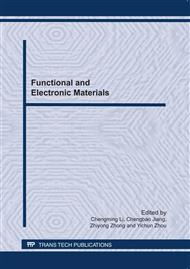p.750
p.756
p.759
p.765
p.771
p.778
p.784
p.791
p.798
Gas Sensing Properties of ZnO Thin Film/Si Heterojunction to Alcohols
Abstract:
The polycrystalline zinc oxide (ZnO) film was deposited on p-Si substrate by radio-frequency (RF) magnetron sputtering. The structure and morphology of the ZnO thin films are characterized by X-ray diffraction (XRD), the energy dispersive analysis of X-ray (EDX) and scanning electron microscope (SEM). The gas sensing properties of the ZnO/Si heterojunctions for alcohols with different chain lengths were investigated at room temperature. It is found that the current-voltage (I-V) characteristics of the ZnO/Si heterojunctions are sensitive to isopropanol, ethanol and methanol gas. We discussed a possible gas sensing mechanism of ZnO/Si heterojunction. The sensitivity of the ZnO/Si heterojunctions to the gases decreases from isopropanol to methanol and to ethanol at the same concentration. It can be explained by the volume effect and electron donating effect.
Info:
Periodical:
Pages:
798-802
Citation:
Online since:
June 2011
Authors:
Keywords:
Price:
Сopyright:
© 2011 Trans Tech Publications Ltd. All Rights Reserved
Share:
Citation:


